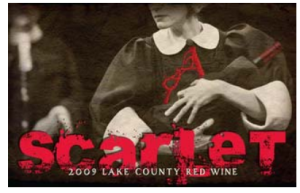In July of 2012, Steele Wines, Inc. filed an application to register a mark with the U.S. Patent and Trademark Office asserting use in commerce since May 2012. See 15. U.S.C. § 1051(a). The mark, which is pictured below, features the words, “A Scarlet 2009 Lake County Red Wine” with a woman in Puritan era costume.
After filing, the trademark examining attorney refused to grant registration on the grounds that the mark of Steele Wines, Inc. resembles a previously registered mark “The Scarlet Letter” for “‘wine’ in International Class 33 as to be likely to cause confusion.” In re Steele Wines, Inc., Serial No. 85683619 (August 23, 2013); see 15 U.S.C. § 1052(d). Shortly after the examining attorney refused to grant applicant trademark registration, applicant appealed the refusal.
In its appeal, applicant argued the following:
- The cited registration (i.e., “The Scarlet Letter,” trademark registration as per here) is weak and “thus entitled to a narrow scope of protection;”
- As a result, the difference between Steele Wines’ mark and the registrant’s mark is sufficient to distinguish the two marks; and
- In support of the above altercation, Steele Wines referred to registration for the mark Scarlet Harlot, Registration No. 4063036 and Registration No. 4107973; Scarlet Ridge, Registration No. 3218299; and Scarlatta, Registration No. 2005383.
In re Steele Wines, Inc., supra.
The examining attorney, upon appeal, maintained the following:
- The channels of trade and consumers are the same;
- The marks of “A Scarlet” and “The Scarlet Letter” are similar to the extent that both marks are the name of Nathaniel Hawthorne’s The Scarlet Letter, a classic and well-known American novel; and
- Applicant’s mark, which includes the term “Scarlet” in bold, red lettering and a woman dresses in Puritan-era clothing with the letter “A” inscribed on her chest, connotes Hawthorne’s novel.
Id.
The Board examined the abovementioned facts when analyzing the likelihood of confusion issue. “In any likelihood of confusion analysis, two key considerations are the similarities between the marks and the similarities between the goods.” Id. citing Federated Foods, Inc. v. Fort Howard Paper Co., 544 F.2d 1098, 192 USPQ 24, 29 (CCPA 1976). In its analysis, the Board turned to the first du Pont factor regarding similarity of foods, affirming that applicant’s goods are identical to those of the registered mark and thus “must be presumed to travel in the same channels of trade and be sold to the same classes of consumers.” Id.
After confirming the identicalness of the goods, the Board then turned to the second du Pont factor: the comprehensive similarity or dissimilarity of the marks with respect to appearance, sound, connotation, and commercial impression. Id. citing In re E. I. du Pont De Nemours & Co., 177 USPQ at 567. The Board found that the marks were significantly similar as per the following reasons:
- Both marks contain the term “SCARLET” as a prominent feature;
- Registrant’s mark contains “THE SCARLET LETTER,” the primary significance of which is Hawthorne’s novel;
- Applicant’s mark consists of the term “SCARLET” as a prominent word and a “woman dressed in puritan garb with a large, scarlet colored letter ‘A’ affixed to the bodice of her dress, and carrying a swaddled wine bottle in place of a child” along with a second figure dressed in similar clothing;
- The combination of the images, use of the red color, letter “A,” and the term “SCARLET” in applicant’s mark “unmistakably evoke the novel The Scarlet Letter;” and
- Applicant’s wording, “2009 Lake County Red Wine,” is descriptive “if not generic” and adds marginally to the overall mark.
Id.
Additionally, the Board found that because the applicant’s mark referred to The Scarlet Letter and the registrant’s mark is “The Scarlet Letter,” the marks are highly similar “in connotation and, as a whole, convey highly similar commercial impressions.” Id. Notably, similarity in any one of the du Pont factors is sufficient to support a likelihood of confusion determination. The Board noted that the existence of several third-party registrations was not enough to compel an alternate result and further discussed the differing factors of each referenced mark. Thus, in totality, the Board found “that the similarities in connotation and commercial impression would lead consumers to mistakenly believe that the identical goods identified thereby emanate from a common source.” Id. The Board affirmed the examining attorney’s decision, refusing the registration under Trademark Act Section 2(d).
Photos property of U.S. Patent and Trademark Office Trademark Trial and Appeal Board, In re Steele Wines, Inc., Serial No. 85683619 (August 23, 2013). For another analysis, please see WYHA? Section 2(d) and Faulty Specimen Refusals Sink SCARLET Wine Application.
For more information on wine or alcohol law, labeling, or trademark, please contact Lindsey Zahn.
DISCLAIMER: This blog post is for general information purposes only, is not intended to constitute legal advice, and no attorney-client relationship results. Please consult your own attorney for legal advice.
